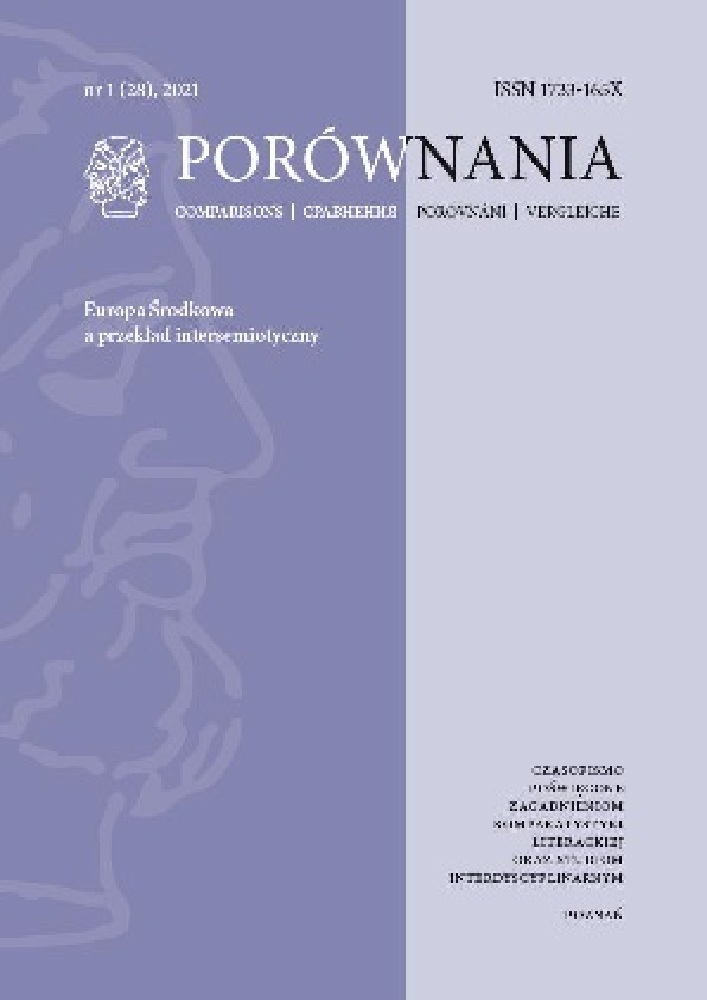Abstract
The article presents examples of concrete poetry in Polish and German, examples that simultaneously meet the two following criteria: 1) they combine both literary and visual elements, and 2) can be considered as litanies because of the pattern of repetition used. A question is posed as to whether the poems are based on the same concept of space-time as in the medieval litanies. As the analysis shows, inter-semiotic relations between the linguistic and the visual aspects of the poems are indicative of a substantial divergence between Polish and German-language concrete poetry as regards their access to the generic worldview of the litany.
References
Benveniste Émile (1977), Semiologia języka, przeł. Krystyna Falicka, w: tenże, Znak, styl, konwencja, wyb. Michał Głowiński, Czytelnik, Warszawa, s. 11–42.
Bohn Willard (2011), Reading Visual Poetry, Fairleigh Dickinson University Press, Lanham.
Bernstein Nils (2011), “kennen sie mich herren / meine damen und herren“: Phraseologismen in Moderner Lyrik am Beispiel von Ernst Jandl und Nicanor Parra, Königshausen & Neumann, Würzburg.
Bocian Marianna (1979), Odejście Kaina, Zakład Narodowy im. Ossolińskich, Wrocław.
Dawidek-Gryglicka Małgorzata (2012), Historia tekstu wizualnego. Polska po 1967 roku, korporacja Ha!art, Kraków–Wrocław.
Gellner Christoph (2009), „das tier mensch das tier tier der schöpfer beider sei gelobt“: Ernst Jandls radikale religiöse Lyrik, w: Religion und Gegenwartsliteratur: Spielarten einer Liaison, red. Albrecht Grözinger, Andreas Mauz, Adrian Portmann, Königshausen & Neumann, Würzburg, s. 105–117.
Gomringer Eugen (1975), jede sieht es sanders…, karta noworoczna dla przyjaciół, NOWEA, Düsseldorf.
Gomringer Eugen (1977), konstellationen – ideaogramme – stundenbuch, Philipp Reclam jun., Stuttgart.
Higgins Dick (1987), Pattern Poetry: Guide to an Unknown Literature, State University of New York Press, New York.
Jandl Ernst (1997), poetische werke, t. 1–10, red. Klaus Siblewski, Luchterhand, München.
Jandl Ernst (1979), Die poetische Syntax in den Gedichten von Friederike Mayröcker, „Modern Austrian Literature”, t. 12, nr 3/4, s. 237–265.
Jandl Ernst (2008), Ottos Mops hopst, il. Erhard Dietl, cbj, München.
Kremer Aleksandra (2015), Przypadki poezji konkretnej, Instytut Badań Literackich PAN, Warszawa.
Sadowski Witold (2018), Europejski wiersz litanijny. W innej czasoprzestrzeni, Wydawnictwa Uniwersytetu Warszawskiego, Warszawa.
Sadowski Witold (2011), Litania i poezja. Na materiale literatury polskiej od XI do XXI wieku, Wydawnictwa Uniwersytetu Warszawskiego, Warszawa.
Sadowski Witold (2016), Wiersz litanijny w przekładzie na obraz, w: Ikonoklazm i ikonofilia: Między historią a współczesnością, red. Agata Stankowska, Marcin Telicki, Poznańskie Towarzystwo Przyjaciół Nauk, Poznań, s. 61–72.
Sadowski Witold, Kowalska Magdalena, Kubas Magdalena Maria (2020), Studies on Litanies in the Past and Present, w: The Litany in Arts and Cultures, red. Witold Sadowski, Francesco Marsciani, Brepols Publishers, Turnhout, s. 1–24.
Schwens-Harrant Brigitte (2015), Literatur als Litanei, w: Religion und Literatur im 20. und 21. Jahrhundert: Motive, Sprechweisen, Medien, red. Tim Lörke, Robert Walter-Jochum, V&R unipress, Göttingen, s. 353–366.
Sławek Tadeusz (1989), Między literami. Szkice o poezji konkretnej, Wydawnictwo Dolnośląskie, Wrocław.
Sławek Tadeusz (2007), Przed-teo, za-logia. Stanisława Dróżdża teologia przyimków, „Anthropos”, nr 8–9, https://tinyurl.com/58u5y9u4 [dostęp: 01.09.2020].
Toury Gideon (1986), Translation: A Cultural-Semiotic Perspective, w: Encyclopedic Dictionary of Semiotics, t. 2, red. Thomas A. Sebeok, Mouton de Gruyter, Berlin, s. 1111–1124.
Wiesiołowski Aleksandr (1913), Tri glawy iz istoriczeskoj poetiki, w: tenże, Sobranie soczinienij, t. 1, Tipografija Imperatorskoj Akademii Nauk, Sankt-Petersburg, s. 226–481.
License
Utwory opublikowane w czasopiśmie „Porównania”, na platformie Pressto należącej do Uniwersytetu im. Adama Mickiewicza w Poznaniu są udostępniane na licencji Creative Commons Uznanie autorstwa - Bez utworów zależnych 4.0 Międzynarodowe (CC BY-ND 4.0)
Tym samym wszyscy zainteresowani są uprawnieni do korzystania z utworów opublikowanych pod następującymi warunkami:
-
uznania autorstwa — czyli obowiązek podania wraz z rozpowszechnianym utworem informacji o autorstwie, tytule, źródle (odnośniki do oryginalnego utworu, doi) oraz samej licencji
-
bez utworów zależnych — remiksując, przetwarzając lub tworząc na podstawie utworu, nie wolno rozpowszechniać zmodyfikowanych treści.
-
brak dodatkowych ograniczeń — nie można korzystać ze środków prawnych lub technologicznych, które ograniczają innych w korzystaniu z utworu na warunkach określonych w licencji.
Uniwersytet im. Adama Mickiewicza w Poznaniu zachowuje prawo do czasopisma jako całości (układ, forma graficzna, tytuł, projekt okładki, logo itp.).
Autor zachowuje prawa majątkowe, ale udziela zgody Uniwersytetowi im. Adama Mickiewicza w Poznaniu na wykorzystanie dzieła. Autorzy tekstów zakwalifikowanych do publikacji proszeni są o wypełnienie podpisanie i przesłanie umowa (PL) agreement (EN)
Agreement for granting a royalty-free license to works with a commitment to grant a CC sub-license





